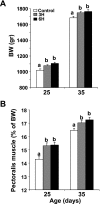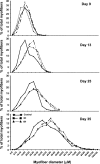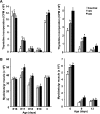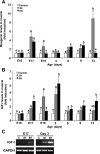Thermal manipulations in late-term chick embryos have immediate and longer term effects on myoblast proliferation and skeletal muscle hypertrophy
- PMID: 19023019
- PMCID: PMC2636946
- DOI: 10.1152/japplphysiol.91090.2008
Thermal manipulations in late-term chick embryos have immediate and longer term effects on myoblast proliferation and skeletal muscle hypertrophy
Abstract
We investigated the cellular and molecular bases for the promotion of muscle development and growth by temperature manipulations (TMs) during late-term chick embryogenesis. We show that incubation at 39.5 degrees C (increase of 1.7 degrees C from normal conditions) from embryonic days 16 to 18 (E16 to E18) for 3 or 6 h daily increased diameter of myofibers as of day 13 of age and enhanced absolute muscle growth relative to controls, until day 35 of age. TMs had immediate (E17) and later (up to 2 wk posthatch) effects in elevating muscle cell proliferation relative to controls. This was indicated by higher DNA incorporation of thymidine and a higher number of cells expressing PCNA in intact muscle, accompanied by higher Pax7 levels, all reflecting a higher number of myogenic cells, and suggesting that the increased hypertrophy can be attributed to a higher reservoir of myogenic progeny cells produced in response to the TM. IGF-I levels were higher in the TM groups than in controls, implying a mechanism by which heat manipulations in chicks affect muscle development, with locally secreted IGF-I playing a major role. Whereas hypertrophy was similar in both TM groups, cell proliferation and Pax7 levels were more robust in the 6-h muscle, mainly posthatch, suggesting a differential effect of various TM periods on cell reservoir vs. hypertrophy and a high sensitivity of myoblasts to relatively small changes in heat duration with respect to these processes, which is manifested in the short and long term.
Figures






References
-
- Adams GR, McCue SA. Localized infusion of IGF-I results in skeletal muscle hypertrophy in rats. J Appl Physiol 84: 1716–1722, 1998. - PubMed
-
- Adams GR, McCue SA, Bodell BW, Zeng M, Baldwin KM. Effects of spaceflight and thyroid deficiency on hindlimb development. I. Muscle mass and IGF-I expression. J Appl Physiol 88: 894–903, 2000. - PubMed
-
- Bruzual JJ, Peak SD, Brake J, Peebles ED. Effects of relative humidity during incubation on incubation on hatchability and body weight of broiler chicks from young breeder flocks. Poult Sci 79: 827–830, 2000. - PubMed
-
- Collin A, Berry C, Tesseraud S, Redon FE, Skiba-Cassy S, Crochet S, Duclos MJ, Rideau N, Tona K, Buyse J, Bruggeman V, Decuyper E, Picard M, Yahav S. Effects of thermal manipulation during early and late embryogenesis on thermotolerance and breast muscle characteristics in broiler chickens. Poult Sci 86: 795–800, 2007. - PubMed
Publication types
MeSH terms
Substances
LinkOut - more resources
Full Text Sources
Miscellaneous

